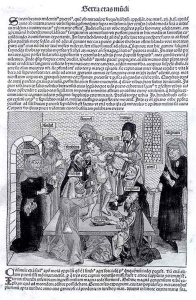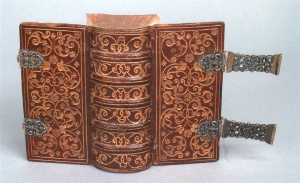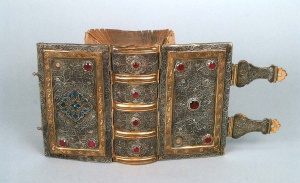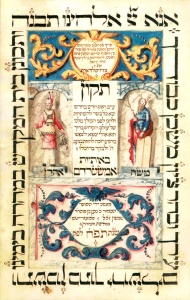Times Of Hope, Seasons Of Despair
The auction of fine Judaica at Kestenbaum & Company unfolds a quilt of diverse Jewish history. As they are auctioned off to the highest bidder, the saga of the Jewish people is traced in these objects and in their stories; from the most scandalous accusations to the most fundamental hope. After the sale on Tuesday, March 11, 2003 they will disappear again from public view until their owners grow restless and sell them or they are exhibited in a museum. But now we have the opportunity to witness history, with its documents and artworks that have been extracted from the fabric of our communal past.
The infamous “Blood Libel” has haunted Jews in the West ever since it was promoted by the anti-semitic Apion in the first century before the Common Era. This calumny resurfaced in the Middle Ages in Norwich, England in 1144 and continued to be used to incite hatred and violence against Jewish communities for centuries, even to this very day. The earliest document of this accusation in the auction is a Spanish account illustrated with woodcut illustrations of the “History of the Death and Glorious martyrdom of the Holy Child of La Guardia” (Lot 28) that was leveled at the Jews of Toledo, Spain in 1490. The child never existed, but the myth was developed by the Catholic Church as a source of intense devotion. It is thought that the libel originated as a way for the Inquisition to prepare the Spanish public for the expulsion of the Jews from Spain two years later.

One of the most infamous blood libels occurred in Trent, Italy in 1475. Right before Easter a Christian infant, Simon, disappeared. His body was found near the house of the head of the Jewish community. The entire Jewish community was arrested and accused of ritual murder. Seventeen Jews were tortured for fifteen consecutive days and nine were burnt at the stake or strangled. The remaining Jews were expelled. The Church intervened but finally justified the libel and designated Simon as a holy martyr. This status was only rescinded in 1965. One illustration from the Nuremberg Chronicle of 1493 (Lot 240) shows nine Jews surrounding the figure of Simon as they extract blood from his live body. This horrific image depicting Jewish men and women as cruel murders, in addition to the Church sponsored cult of Simon, fostered anti-semitic violence against Jews for hundreds of years.
These terrible accusations almost certainly added to the growing anti-Jewish climate that culminated in the public burning of the Talmud in the Campo de Fiori in Rome and in San Marco Square in Venice in 1553. The auction presents a collection of eleven documents (Lot 227) from what may be the personal file of one of the Venetian prosecutors that finally decreed the Talmud was blasphemous and must be banned.
The depth of Jew hatred in Medieval and Renaissance Europe is laid bare in these documents, yet another side of our history is presented as well. Simultaneously, it seems, these were also times of hope.
In 1516, Daniel Bomberg, a Christian, published a Chumash in Venice and began his career as one of the first and most prominent Christian printers of Hebrew books. In 1520 he published the first complete editions of the Babylonian and Yerushalmi Talmud. We still use his pagination in our gemara today. The auction presents us with the second edition of the rabbinic Bible (Mikra’ot Gedolot), published in 1524-1525 (Lot 38) and edited by Jacob b. Chaim ibn Adonijah, a learned Jew. It was widely praised by the Jewish public in its day. This Bomberg edition was the first to present the masoretic text alongside the traditional rabbinic commentaries and became the standard used for all subsequent editions.

For all the troubles that were erupting in Italy, Jews were prospering elsewhere. A Chumash published in 1573 in Antwerp (Lot 53) displays a luxurious calf leather binding elegantly tooled in an arabesque gold pattern. The rich crimson leather binding, similar to the contemporaneous rare Grolier bindings, denotes ownership by an affluent Jewish patron with sophisticated tastes who wished to honor his edition of the Torah with the finest craftsmanship and quality binding.

A number of fine quality bindings characterize this auction. This work finally climaxes in the binding for a Chumash, with megillot and haftarot of 1783 from Breslau (Lot 56). The fine Polish silver filigree and gilt binding, set with colored stones, is a masterpiece of craftsmanship and sensitive design. A simple design with delicately ornate silverwork, this sefer must have given great joy to its owner as he learned the weekly parasha holding a stately gem of bookbinding art.
The sofer and artist is Nathan ben Samson of Mehzeritch and this is one of a handful of his masterpieces that we have from the eighteenth century. He was originally from Moravia (eastern Czechoslovakia, near Hungary) and specialized in the traditions of Renaissance book illumination that had survived intact in some Germanic countries. This sefer opens with an impressive architectural title page sporting elaborate dedicatory cartouches framed by the figures of Aaron and Moses in red and blue colored ink. Each page that follows is graced with decorated letters that accent his careful design. Many of the decorated letters are delightfully ornate with multi-colored inks while others are simply rendered with imaginative floral designs in sepia ink. Some of the Names of God are ennobled with gold leaf. This artist/sofer carefully considered the design of each page and thereby provided multiple delights for the patron of this tikun.

As the month draws to a close and the moon diminishes, the kabbalists saw this natural phenomenon as symbolic of the exile of the Shechinah only to be remedied by the renewal found in each new moon. The tikun Erev Rosh Chodesh and the renewal of the moon symbolically reminds us of the promised redemption from exile. Holding this masterpiece of Jewish art in my hands, a treasure filled with so much simple beauty and faith, I can actually believe that the redemption, though it tarries, is closer than ever before. This artistic experience makes the terrors of our history a little more bearable.
Kestenbaum & Company (212 366 1197)
Viewings at The Doral Park Avenue Hotel
70 Park Avenue, New York, NY
Extensive Illustrated Catalogue at www.kestenbaum.net